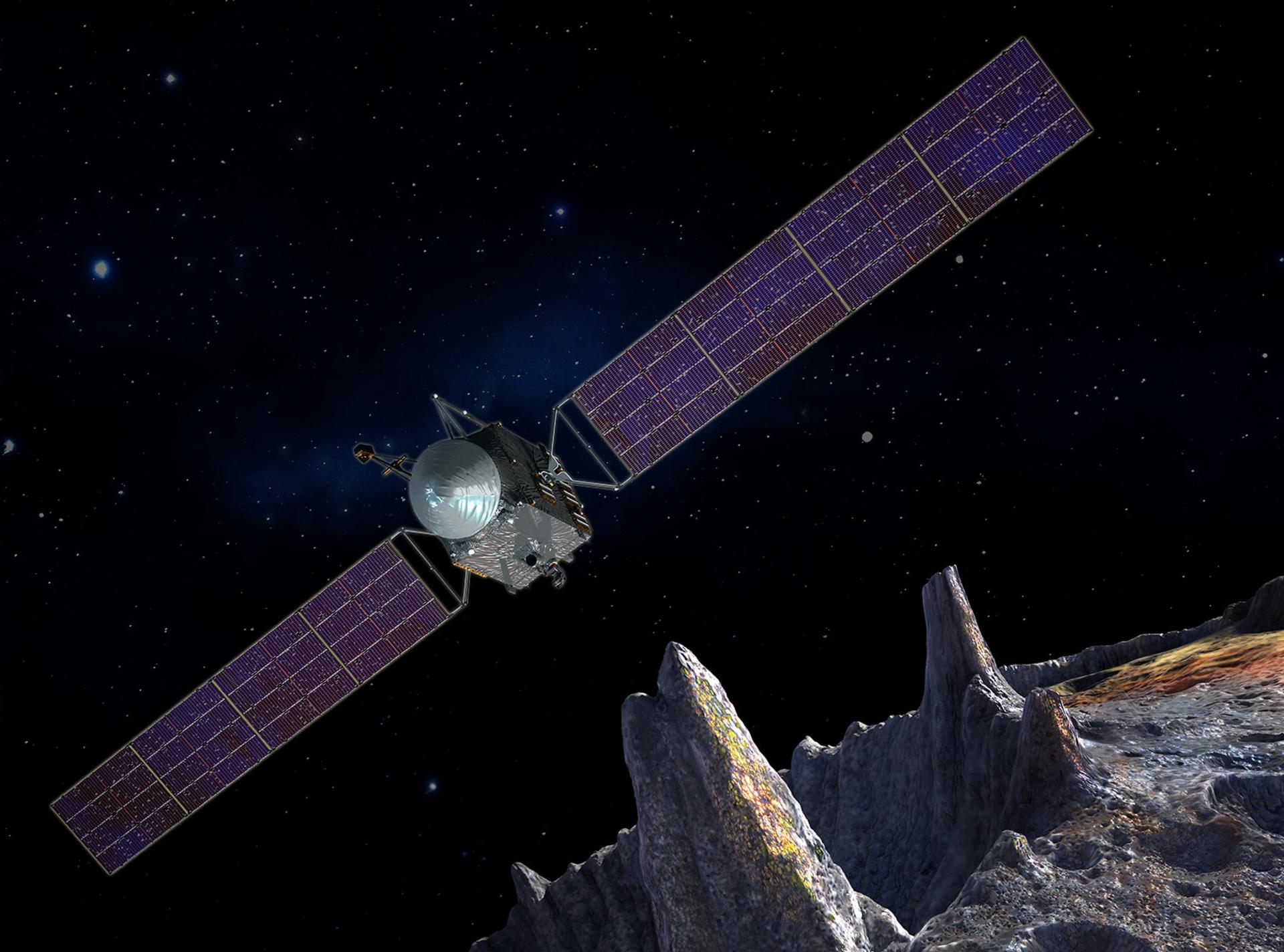Two new NASA missions look to asteroids for clues about our early solar system
An artist's concept of the Psyche spacecraft is pictured here. The Psyche mission will explore an asteroid thought to be a stripped planetary core.
Sure, they're space rocks that sometimes hurtle past Earth a little too close for comfort — asteroids, that is. But for researchers involved in two new NASA missions titled Lucy and Psyche, asteroids are much more than an occasional nuisance: They're time capsules that could unlock secrets of the early solar system.
The Lucy mission — planned for launch in 2021 — will explore six asteroids known as Trojans. According to Cathy Olkin, deputy principal investigator for the Lucy mission, the Trojan asteroids orbit along with Jupiter in two “swarms.” One swarm is 60 degrees ahead of Jupiter in its orbit, and the other swarm is 60 degrees behind.
“So they’re in a very different location than most asteroids,” she says. Olkin and other scientists hypothesize that the Trojan asteroids were swept up as the solar system formed, and became trapped in Jupiter’s gravitational pull.
“One theory is that the giant planets migrated out and captured these … protoplanetary objects as the solar system was forming. And so these are the remnants of what would have gone into all our planets,” Olkin says.
To study the six asteroids, Olkin’s team found “an amazing trajectory” that will take the Lucy craft to both swarms, hovering around 260 miles above the chosen objects. She says they’ll study the surface of each asteroid for clues about how they formed.
“We're going to look at Trojan asteroids of different colors, different spectral types, which tells us something about the surface composition, and different sizes, so that we can compare and contrast how these objects look at the geologic level and at the composition level,” she says.
Olkin and her team hope the Lucy mission will transform our understanding of solar system formation and evolution, just as its namesake, the Lucy fossil, “transformed our understanding of hominid evolution,” she says.
Another mission, Psyche, is scheduled to head to the huge, main asteroid belt between Mars and Jupiter in 2023. It’s focused on studying an asteroid — also named Psyche — which appears to be made entirely of metal.
“About six years ago, we started wondering what would be the best place to go in the solar system to understand more about the very beginning of planet formation, this process called 'differentiation,'” says Lindy Elkins-Tanton, principal investigator on the mission.
She explains that in planetary differentiation, melting occurs and heavy metals sink to the middle of planets, forming cores like the one Earth has. But Earth’s core is hidden thousands of miles below the surface, so Elkins-Tanton and her team hope an up-close glimpse of Psyche will provide critical clues about what lies beneath us, and how cores like ours formed. The mission will orbit for 20 months, getting as close as about 60 miles above the asteroid, she says.
“[Psyche] seems to be just a world of metal with almost no rock on the surface of it,” Elkins-Tanton explains, adding that it’s the only one like it in our solar system. “We think it had a lot of destructive collisions in that high-speed, high-energy, early solar system that just broke all the rock off the outside, leaving that, the core, available for us to see.”
Elkins-Tanton estimates that if the Massachusetts-sized Psyche is the full core of a destroyed planet, it was probably larger than Vesta, the second-most-massive asteroid in the main asteroid belt. “But if it's a piece, like a droplet of a core that was splashed out in a giant impact, it could be a part of a body even as large as Mars.”
She clarifies that scientists aren’t expecting Psyche to have the same composition as the cores of big, hot, high-pressure planets like the Earth, Venus and Mars. But some have theorized that small, early planets contained carbon and oxygen in their cores, and when they collided with growing planets, that made them even bigger. The mission team hopes Psyche will provide some clues.
“We're going to be looking at what the trace elements are in Psyche that would have been delivered to the Earth by these little planetesimals as the Earth was growing,” Elkins-Tanton says.
Speaking of materials, she points out that humans have never seen a metal world before, so whatever Psyche is composed of could make for a wild first glimpse. The latest hypotheses indicate the asteroid could have giant, miles-high metal cliffs, wrought when its outer shell shrank to accommodate the freezing and shrinking of its interior.
“Those cliffs could be made of iron-nickel metal, or they could be made of the same material that pallasite meteorites are made of, and that is metal mixed with bright green mineral crystals, which is a pretty mind-boggling idea,” she says. “It could have sulfur lava flows on the surface, but the sulfur could be yellow or orange or white.” Even craters might look different on an all-metal surface. “They could have frozen metal spires,” she adds. “We don’t know.”
She’s content to live with the mystery — at least until the Psyche mission returns some clues.
“The final message about this is every time we've explored the solar system, the solar system has surprised us. And so we expect to be surprised again.”
This article is based on an interview that aired on PRI's Science Friday. To see an animation of what the flight around Psyche might look like, check out this NASA video.
